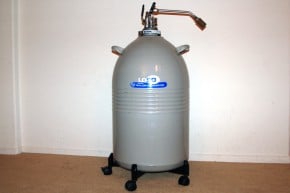Core i7 Extreme Overclocking with LN2
Tools for the Job and Insulation

|
Although finding an LN2 supplier might take some effort, finding an affordable container to store it in will be one of the biggest obstacles on the path to extreme overclocking glory. It is required that you obtain a liquid nitrogen dewar in order to transport and store the potentially dangerous product (though some companies will rent you one). They come in different capacities ranging from 1L to more than 100L. Our research tells us that 25L is the sweet spot for benchers and provides a weekend of sub-zero fun. Unfortunately, new dewars are relatively expensive and can cost over $700 for a 25L model. Ebay is a good place to find used dewars at a fraction of the cost. We landed a 50L Taylor Wharton dewar and added a liquid withdrawal device to conveniently transfer LN2 into a smaller container. Smaller dewars do not require the withdrawal device as they can be picked up and tipped over in order to transfer liquid nitrogen.
The focal point of sub-zero cooling hardware is the pot used to cool whichever heat producing component you intend on overclocking. There are several custom pot makers who provide products to cool processors, videocards, and chipsets. But the most recognized manufacturer is the professional overclocker, k|ngp|n, whose F1 Dragon is widely considered one of the best performing CPU pots on the market. The F1 Dragon is made of 100% copper and comes with mounting hardware as well as insulation to reduce condensation. We also used the aluminum extension kit for the F1, which allows for full pot LN2 benching and nearly doubles the internal volume of the unit.
Chipset blocks are used to replace the stock cooling on motherboards. They take advantage of watercooling in order to lower temperatures and maintain higher overclocks. We used the full board X58 Classified block designed by EK Waterblocks. This particular product cools Northbridge, Southbridge, and the MOSFET power components found next to the CPU socket area. Keeping these hot zones in check allows us to reach higher frequencies and reduces the possibility of killing the motherboard. Just keep in mind that the chipset block is optional and not necessary to accomplish sub-zero temperatures on the CPU.
|
|
|
Whenever sub-zero cooling is used, insulating the CPU socket area is required and a very important step of the process. Insulation is necessary since condensation will form and can potentially kill hardware being used in the setup. A combination of shop towels, insulation foam, and fitted rubber matting was used on our test system and provided an air tight seal between the components. Basically, the goal is to take up empty space with the rubber matting and prevent the possibility of moisture forming in these areas. While there are other methods of insulation, we find this one to be effective and easy to remove from the motherboard.


















